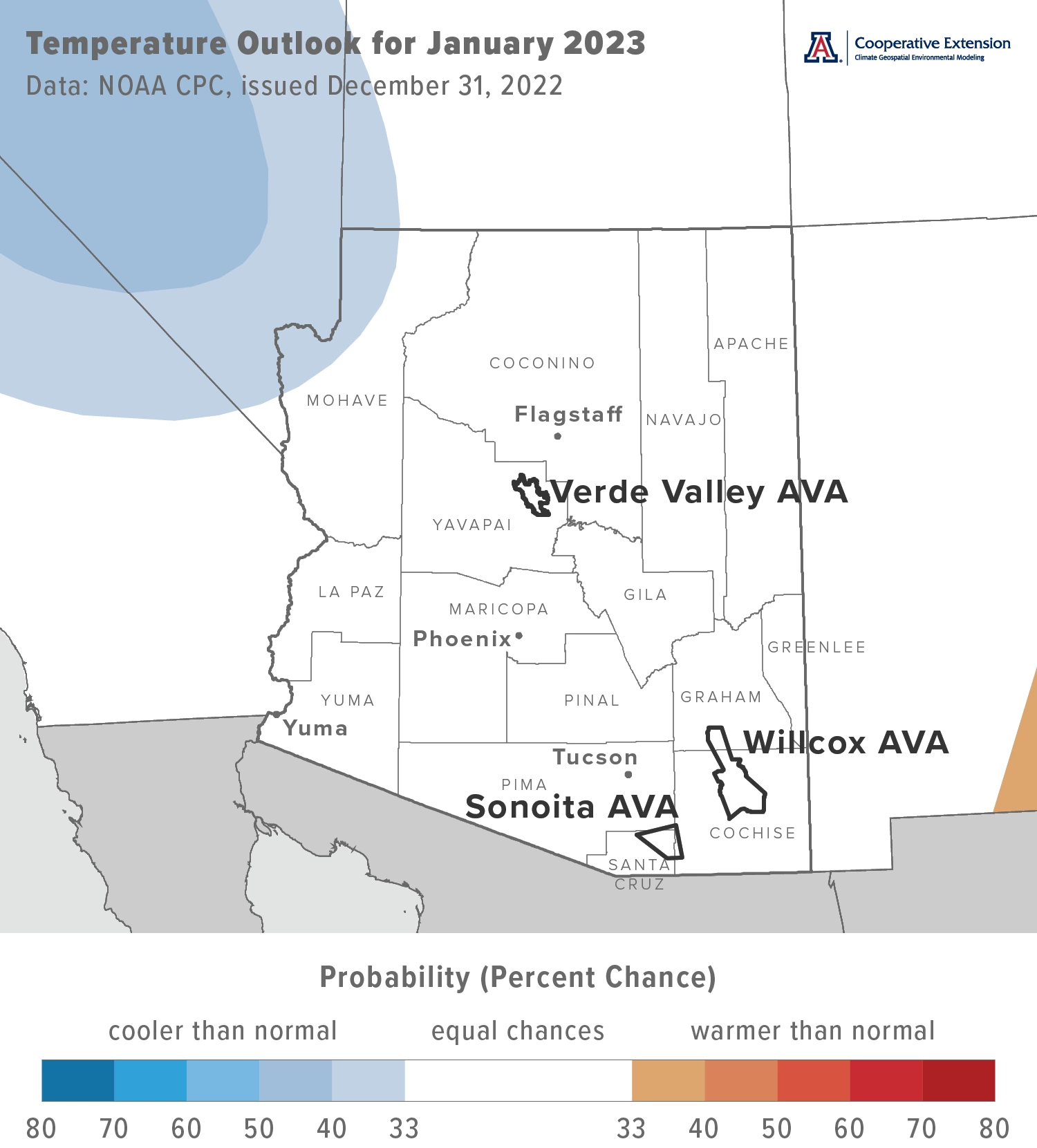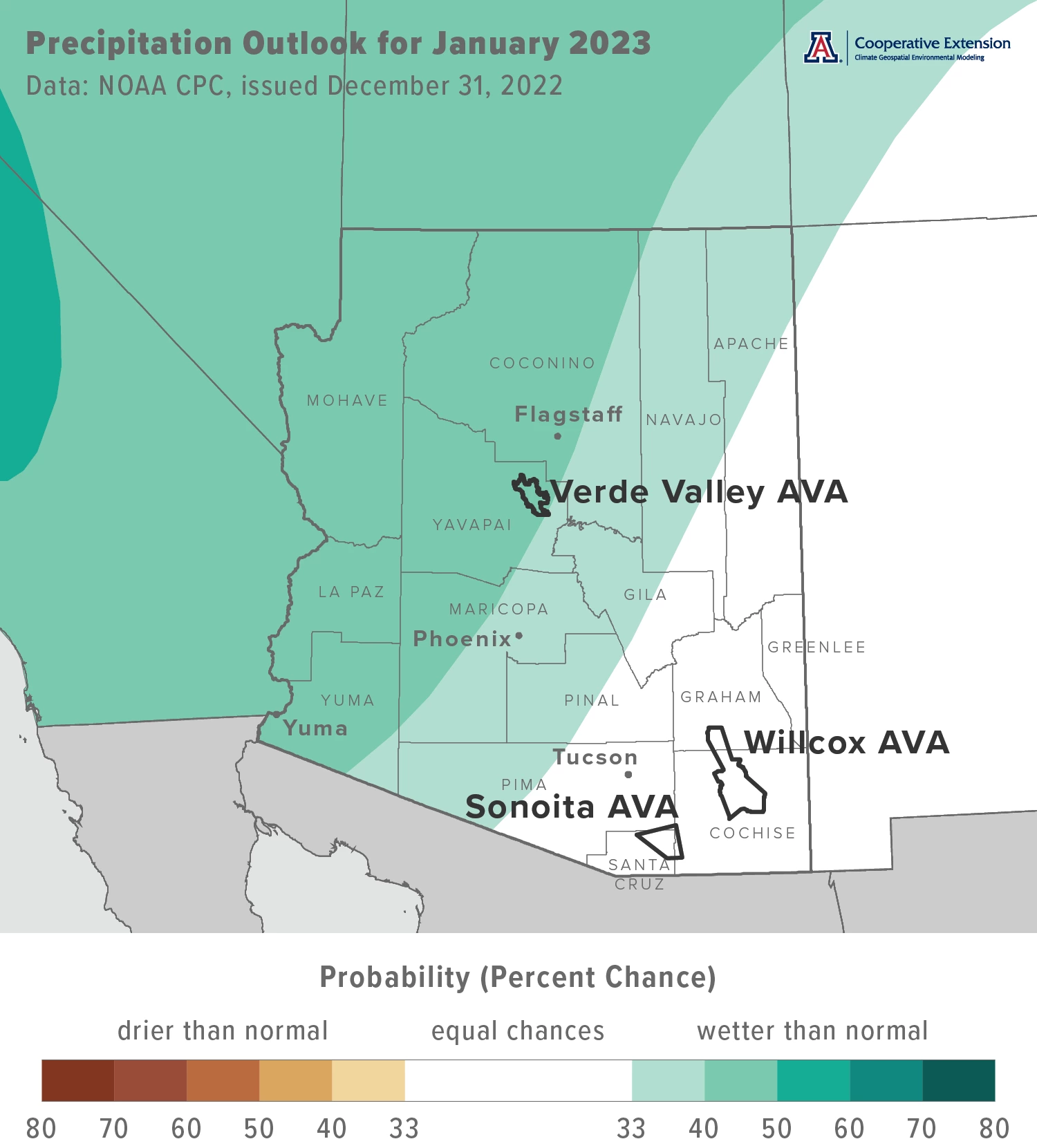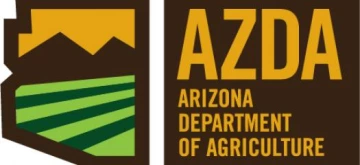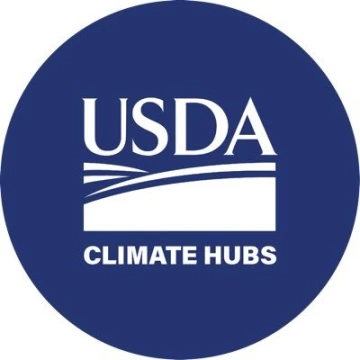< Back to Climate Viticulture Newsletter
Hello, everyone!
This is the January 2023 issue of the Climate Viticulture Newsletter – a quick look at some timely climate topics relevant to wine grape growing in Arizona.
December Recap | January Outlook | Growing Season Review | Extra Notes
A Recap of December Temperature and Precipitation
Monthly average temperatures were 1 to 3 °F above the 1991-2020 normal for most of the eastern one-third of Arizona (light orange and orange areas on map), including parts of the Sonoita and Willcox AVAs. Much of the rest of the state, including the Verde Valley AVA, saw near-normal temperatures (white areas on map). For reference, monthly temperatures in December 2021 generally were 2 to 4 °F above normal for the western two-thirds of the state and 4 to 6 °F above normal for the eastern one-third.
Area-average maximum and minimum temperatures during December 2022 were 59.4 and 33.2 °F for the Sonoita AVA, 56.3 and 31.9 °F for the Verde Valley AVA, and 60.1 and 30.9 °F for the Willcox AVA. Respective December normals are 58.3 and 31.5 °F, 57.2 and 30.0 °F, and 59.0 and 30.2 °F.

Jeremy Weiss
Monthly precipitation totals were more than 125 % of normal for much of the south-central, east-central, and extreme northwestern parts of the state (light aqua, aqua, and blue areas on map), including parts of the Sonoita and Willcox AVAs. Otherwise, totals for many locations were near normal (white areas on map), including the Verde Valley AVA. Precipitation during December 2021 ranged from near to more than 200 % of normal for much of the western two-thirds of the state, and from 25 to 75 % for several areas in the eastern third.
Area-average total precipitation in December 2022 was 2.12 inches for the Sonoita AVA, 1.41 inches for the Verde Valley AVA, and 1.36 inches for the Willcox AVA. Respective December normals are 1.40, 1.37, and 1.08 inches.
Digging into daily weather summaries from 2022 for the AZMet Bonita and Willcox Bench stations in the Willcox AVA, precipitation last month brings dormant-season totals at these locations to 1.39 and 1.42 inches, respectively. Although we might feel fortunate whenever it rains during a La Niña winter, total reference evapotranspiration during the November-December period nonetheless remains higher, with respective values of 4.7 and 4.8 inches, illustrating a need for attention to winter irrigation.
Learn more about PRISM climate data

Jeremy Weiss
The Outlook for January Temperature and Precipitation
There are equal chances for below-, near-, or above-normal temperatures across almost all of Arizona (white area on map). The only exception to this is the extreme northwestern part of the state, where there is a slight increase in chances for below-normal temperatures (light blue area on map). Monthly temperatures in January last year were within 2 °F of normal for much of the state.
Area-average maximum and minimum temperatures during January 2022 were 59.4 and 30.9 °F for the Sonoita AVA, 60.3 and 30.4 °F for the Verde Valley AVA, and 59.3 and 29.2 °F for the Willcox AVA. Respective January normals are 58.7 and 31.2 °F, 58.1 and 30.6 °F, and 59.6 and 30.2 °F.

Jeremy Weiss
Precipitation totals for this month have a slight increase in chances for being above normal across the northwestern two-thirds of the state (light aqua and aqua areas on map), due mostly to a potentially wet start to the month. For the southeastern one-third, there are equal chances for below-, near-, or above-normal totals (white area on map). Precipitation during January 2022 was less than 50 % of normal for much of Arizona.
Area-average precipitation totals in January 2022 were 0.63 inches for the Sonoita AVA, 0.44 inches for the Verde Valley AVA, and 0.71 inches for the Willcox AVA. Respective January normals are 1.24, 1.45, and 1.07 inches.
Although the rare La Niña three-peat this winter still partly influences what we see in the monthly outlooks, it looks like the event is fading away. There is a 71 % chance that ENSO-neutral conditions finally appear during the February-April period. This is the most recent official forecast for ENSO, or El Niño Southern Oscillation, parts of the atmosphere and ocean across the tropical Pacific Ocean that cause El Niño and La Niña events.
To stay informed of long-range temperature and precipitation possibilities beyond the coverage of a standard weather forecast, check in, too, with the six-to-ten-day outlook and eight-to-fourteen-day outlook issued daily by NOAA’s Climate Prediction Center.

Jeremy Weiss
A Review of the 2022 Growing Season
As the second part of our review of this past growing season, we focus on total precipitation in the three Arizona AVAs. We again organize the information by different periods. For simplicity, pre-veraison is during the months of April, May, and June (top graph), ripening and harvest is during the months of July, August, and September (middle graph), and post-harvest is during the months of October and November (bottom graph).
Pre-veraison precipitation totals were below the 1991-2020 normal (semi-transparent horizontal lines on graphs) for the Verde Valley AVA (orange lines on graph), near normal for the Sonoita AVA (green lines on graph), and above normal for the Willcox AVA (purple lines on graph). Granted, amounts during this part of the growing season often are only about 1 or 2 inches, helping define what is the dry and, as the case may be in June, hot foresummer that precedes the monsoon. The relatively low precipitation does little to counter the roughly 0.2 to 0.3 inches lost daily to evapotranspiration at this time of year, as estimated at the AZMet Bonita and Willcox Bench stations in the Willcox AVA. It does, however, help keep some disease pressure and related management needs relatively lower.
Precipitation totals during the ripening and harvest period were above normal for the Sonoita and Willcox AVAs, with each area recording one of the highest seasonal amounts over the past four decades. In partial contrast, rainfall in the Verde Valley AVA during this part of the growing season was near normal. This comes on the heels of near-record to record-wet conditions in 2021 and near-record to record-dry conditions in 2020 for all three AVAs. From our perspective, vineyard and winery notes from these three past vintages will be valuable for future ones when it comes to evaluating variety viability for what is expected to be a more variable and extreme summer climate. In the case of 2022 and the Sonoita and Willcox AVAs, identifying the varieties that did a better job handling disease pressure and maintaining pH despite above-normal rainfall could help hedge against challenging monsoon conditions.
Post-harvest precipitation totals had all three Arizona AVAs near their normal amounts of 1.5 to 2.0 inches. Despite the growing season winding down and wrapping up, rainfall at this time of the year nonetheless factors into some post-harvest activities like irrigation and establishment of cover crops.

Jeremy Weiss
Attention all growers, viticulturists, and vineyard owners! University of Arizona Cooperative Extension is conducting a Statewide Viticulture Needs Assessment and needs your help. Topics will include production, irrigation management, soil fertility, and management of pests, pathogens, and disease, among others. Your anonymous feedback is essential and will inform Cooperative Extension as to how it can best serve the wine grape industry. Please click here to access the survey, and contact Matt Halldorson, Yavapai County Director and Associate Agent in Agriculture and Natural Resources with Cooperative Extension, with any questions.
Be sure to mark down March 6th and 7th this year for the Arizona Viticulture Strategic Planning Summit at Biosphere 2 in Oracle. In collaboration with Designing Arizona Signatures and Visit Southern Arizona, University of Arizona Cooperative Extension invites you to the two-day event to help detail and expand research and extension plans for the industry, including a potential research center for state wine grape growers. Registration and lodging details will be announced soon. Please contact Joshua Sherman, Associate Area Agent in Commercial Horticulture with Cooperative Extension, with any questions.
For those of you in southeastern Arizona, including the Sonoita and Willcox AVAs, Cooperative Extension manages an email listserv in coordination with the Tucson forecast office of the National Weather Service to provide information in the days leading up to agriculturally important events, like cold-air outbreaks and the occasional winter storm. Please contact us if you'd like to sign up.
And for those of you in north-central and northeastern Arizona, including the Verde Valley AVA, Cooperative Extension also now manages an email listserv in coordination with the Flagstaff forecast office of the National Weather Service to provide similar information for this part of the state. Please contact us if you'd like to sign up.
Undergraduate students in the College of Agriculture and Life Sciences at the University of Arizona are looking for internships with businesses and companies in the viticulture and winery industries. Please contact Danielle Buhrow, Senior Academic Advisor and Graduate Program Coordinator in the Department of Agricultural and Resource Economics, for more information.
Please feel free to give us feedback on this issue of the Climate Viticulture Newsletter, suggestions on what to include more or less often, and ideas for new topics.
Did someone forward you this newsletter? Please contact us to subscribe.
Have a wonderful January!
With current and past support from:






